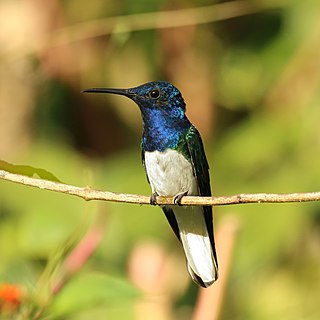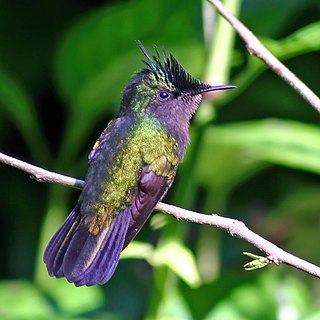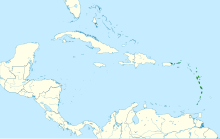
The corn bunting is a passerine bird in the bunting family Emberizidae, a group now separated by most modern authors from the finches, Fringillidae. This is a large bunting with heavily streaked buff-brown plumage. The sexes are similar but the male is slightly larger than the female. Its range extends from Western Europe and North Africa across to northwestern China.

The ruby-topaz hummingbird, commonly referred to simply as the ruby topaz, is a species of hummingbird in the subfamily Polytminae, the mangoes. It is found in Aruba, Bolivia, Bonaire, Brazil, Colombia, Curaçao, French Guiana, Guyana, Panama, Suriname, Trinidad and Tobago, and Venezuela.

The copper-rumped hummingbird is a species of hummingbird in the "emeralds", tribe Trochilini of subfamily Trochilinae. It is found in Tobago, Trinidad, Venezuela, and possibly Grenada.

The white-necked jacobin is a medium-size hummingbird that ranges from Mexico south through Central America and northern South America into Brazil, Peru and Bolivia. It is also found in Trinidad & Tobago.

The red-billed streamertail, also known as the doctor bird, scissor-tail or scissors tail hummingbird, is a species of hummingbird in the "emeralds", tribe Trochilini of subfamily Trochilinae. It is endemic to Jamaica and is the national bird of the country.

The rufous-breasted hermit or hairy hermit is a hummingbird that breeds from Panama south to Bolivia, and on Trinidad, Tobago and Grenada. It is a widespread and generally common species, though local populations may change in numbers and disappear altogether in marginal habitat.

The blue-tailed emerald is a hummingbird in the "emeralds", tribe Trochilini of subfamily Trochilinae. It is found in tropical and subtropical South America east of the Andes from Colombia east to the Guianas and Trinidad, and south to northern Bolivia and central Brazil.

The white-throated toucan is a near-passerine bird in the family Ramphastidae found in South America throughout the Amazon Basin including the adjacent Tocantins and Araguaia River drainage. It prefers tropical humid forest, but also occurs in woodland and locally in riverine forest within cerrado.

The volcano hummingbird is a species of hummingbird in tribe Mellisugini of subfamily Trochilinae, the "bee hummingbirds". It is found in Costa Rica and Panama. This hummingbird is the one that appears on the 20 thousand colones bill from Costa Rica.

The Hispaniolan mango is a species of hummingbird in the subfamily Polytminae. It is endemic to the Caribbean island of Hispaniola.

The Jamaican mango is a species of hummingbird in the subfamily Polytminae. It is endemic to Jamaica.

The blue-headed hummingbird is a species of hummingbird in the "emeralds", tribe Trochilini of subfamily Trochilinae. It is found only on the islands of Dominica and Martinique in the Lesser Antilles.

The caribs are a genus, Eulampis, of hummingbirds in the family Trochilidae. The genus contains two species, both of which are endemic to the islands of the Caribbean. The genus name comes from the Ancient Greek word eulampēs meaning 'bright shining'.

The purple-throated carib is a species of hummingbird in the subfamily Polytminae. It is resident on most of the islands of the Lesser Antilles and has occurred as a vagrant both further north and south.

The black-eared fairy is a species of hummingbird in the subfamily Polytminae, the mangoes. It is found in every mainland South American country except Argentina, Chile, Paraguay, and Uruguay.

The rufous-throated sapphire is a species of hummingbird in the "emeralds", tribe Trochilini of subfamily Trochilinae. It is found in Bolivia, Brazil, Colombia, Ecuador, the Guianas, Peru, Venezuela and possibly Argentina and Paraguay.

The vervain hummingbird is a species of hummingbird in tribe Mellisugini of subfamily Trochilinae, the "bee hummingbirds". It is found on Hispaniola and Jamaica.

The Antillean crested hummingbird is a species of hummingbird in the family Trochilidae. Found across Anguilla, Antigua and Barbuda, Barbados, Dominica, Grenada, Guadeloupe, Martinique, Montserrat, north-east Puerto Rico, Saba, Saint-Barthélemy, Saint Kitts and Nevis, Saint Lucia, Saint Martin, Saint Vincent and the Grenadines, Sint Eustatius, the British Virgin Islands, the U.S. Virgin Islands, and the Lesser Antilles, while it has also been recorded as a vagrant in Florida, USA.

The fork-tailed woodnymph is a species of hummingbird in the "emeralds", tribe Trochilini of subfamily Trochilinae. It is found in every mainland South American country except Chile and Uruguay.

The sooty barbthroat is a hummingbird species in the family Trochilidae. It is found in Brazil and French Guiana.























